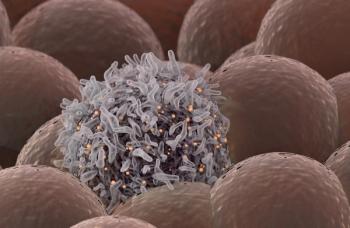
Avastin Improves DFS in High-Risk Melanoma
Results of a preplanned interim analysis of the AVAST-M trial indicate that bevacizumab may have a beneficial effect on disease-free survival in patients with melanoma at high risk for recurrence.
Results of a preplanned interim analysis of the AVAST-M trial indicate that bevacizumab (Avastin) may have a beneficial effect on disease-free survival in patients with melanoma at high risk for recurrence. Longer follow-up will be needed before any effect on overall survival, the primary endpoint of the study, will be seen.
“Most patients with locoregional [melanoma] are treated surgically; adjuvant therapy to prevent or reduce risk of recurrence has not been established for routine use since, to date, the evidence of benefit is very limited,” study author Pippa G. Corrie, MD, of Cambridge Cancer Trials Centre, told Cancer Network. “To date, most adjuvant therapies tested have been interferon and melanoma vaccines. Targeting angiogenesis has not previously been used as an adjuvant strategy in melanoma.”
The AVAST-M study is a multicenter, open-label trial that randomly assigned 1,343 patients to treatment with bevacizumab (n = 671) or observation (n = 672). At the time of this interim analysis, the median follow-up in both patient groups was 25 months; 21% of patients in the bevacizumab arm and 22% of patients undergoing observation had died.
At this analysis, Corrie and colleagues found no significant difference in overall survival between the two groups. However, there was a significant difference in disease-free interval for bevacizumab compared with observation (HR = 0.83; 95% CI, 0.70-0.98). Interestingly, the researchers also observed that the significant improvement in disease-free interval was confined to those patients assigned bevacizumab who had a BRAF mutation (HR = 0.60; 95% CI, 0.43-0.85).
“This early signal of improved disease-free interval with adjuvant bevacizumab is very encouraging, and longer follow-up is required to determine whether this translates to an overall survival benefit and whether the impact of BRAF mutation status holds up over time,” Corrie said. “The size of the benefit with bevacizumab may ultimately be small, but is equivalent to that reported in the meta-analysis of adjuvant interferon trials. However, our study suggests that bevacizumab may be a better tolerated drug compared with interferon.”
In an editorial that accompanied the article, Vernon K. Sondak, MD, of Moffitt Cancer Center, and Geoffrey T. Gibney, MD, of the University of South Florida Morsani College of Medicine, pointed out the need for continued improvement in the adjuvant treatment of patients with high-risk melanoma. However, they also pointed out that no trial to date has shown that adjuvant use of bevacizumab has improved survival in any tumor type.
In addition, Sondak and Gibney draw attention to the use of disease-free survival as an outcome instead of relapse-free survival.
“Disease-free interval is subtly different from relapse-free survival because deaths due to non-melanoma causes are not included in its calculation; as such, relapse-free survival should remain the standard relapse endpoint for trials of adjuvant melanoma,” they wrote. “Even if we assume that relapse-free survival was improved by the same amount as disease-free interval in the AVAST-M trial, and that this improvement was statistically significant, bevacizumab does not surpass the effectiveness of interferon sufficiently enough to justify its use in clinical practice.”
Newsletter
Stay up to date on recent advances in the multidisciplinary approach to cancer.


















































































